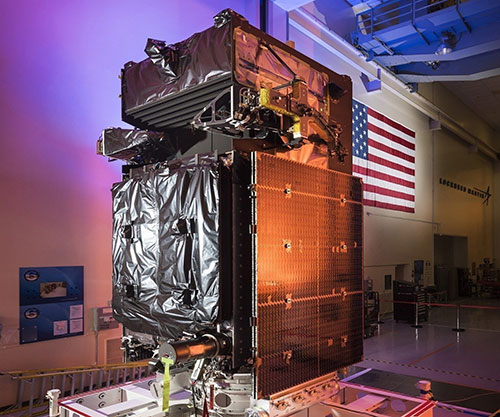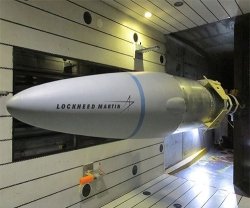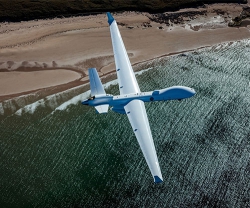The U.S. Space Force’s Space and Missile Systems Center successfully delivered the fifth Space Based Infrared System satellite (SBIRS GEO-5) to the processing facility at Cape Canaveral Space Force Station, Florida.
The satellite traveled across the country from the Lockheed Martin Space Systems Center satellite integration facility in Sunnyvale, California via a C-5M Super Galaxy on March 18. The SBIRS team based out of Los Angeles Air Force Base, California, and the flight crew from the 60th Air Mobility Wing based at Travis Air Force Base, California worked together to ensure the safe and timely transportation of the satellite.
The delivery of the satellite to Cape Canaveral brings GEO-5 one crucial step closer to its anticipated May 17 launch. The next step is the execution of the final ground testing activities to verify satellite integrity, beginning with a Launch Base Confidence Test. After successful completion of testing, consent to fuel will be given and satellite fueling operations will begin. These activities are vital to the mission team’s efforts to use GEO-5’s propulsion system to guide the satellite to geosynchronous orbit following its separation from a United Launch Alliance Atlas V rocket. Encapsulation and integration of the satellite onto the launch vehicle will be completed prior to launch.
“This delivery represents a major milestone for the SBIRS program and is a critical step towards putting GEO-5 on orbit for the warfighter. It represents the hard work and dedication of the combined team of Lockheed Martin, Northrop Grumman, the Aerospace Corporation, multiple support contractors and government personnel,” said Lt. Col. Ryan Laughton, SBIRS GEO-5/6 production materiel leader.
The SBIRS constellation is designed to replace the legacy Defense Support Program (DSP), which has provided missile-detection and missile warning capabilities to the nation for more than 45 years. SBIRS provides persistent infrared surveillance to support missile warning, missile defense, battlespace awareness and technical intelligence missions.
The U.S. Space Force’s Space and Missile Systems Center, located at the Los Angeles Air Force Base in El Segundo, California, is the center of excellence for acquiring and developing military space systems. SMC’s portfolio includes space launch, global positioning systems, military satellite communications, a meteorological satellite control network, range systems, space-based infrared systems, and space situational awareness capabilities.
Built in a record time and at no additional cost to the government for the upgrade, SBIRS GEO-5 is the first military space satellite built on the company’s modernized, modular LM 2100™ combat bus. SBIRS GEO-6, launching in 2022, is also being built on the new bus designed for speed and resilience. Both SBIRS GEO-5 and GEO-6 are slated to join the U.S. Space Force’s constellation of missile warning satellites, equipped with powerful scanning and staring infrared surveillance sensors, which protect our nation 24-7. These sensors collect data that allow the U.S. military to detect missile launches, support ballistic missile defense, expand technical intelligence gathering and bolster situational awareness on the battlefield.
The LM 2100 combat bus is the result of a Lockheed Martin internally-funded, multi-year modernization initiative. It is designed to provide greater resiliency and cyber-hardening; enhanced spacecraft power, propulsion and electronics; common components and procedures to streamline manufacturing; and a flexible design that reduces the cost to incorporate future, modernized sensor suites. Lockheed Martin added even further enhanced resiliency features to the LM 2100 to create an initial ‘combat bus’ for the Space Force. SBIRS GEO-5 has proven itself a valuable incremental step towards achieving the resilient missile warning that will be provided by the Next Gen OPIR Block 0 System, the follow-on to SBIRS.
In June 2015, the Air Force agreed to rebaseline SBIRS GEO-5 and GEO-6 to upgrade both satellites to Lockheed Martin’s modernized LM 2100 bus at no additional cost. From that point, SBIRS GEO-5 was completed in approximately five years, in line with the government’s need to increase production speed and address emerging threats, and still supporting the government’s original 2021 launch date.
Besides SBIRS GEO-5 and GEO-6, the LM 2100 space vehicle is the baseline for three Next Gen OPIR Block 0 GEO satellites expecting to launch starting in 2025; and the future GPS III Follow On (GPS IIIF) satellites, which are expected to launch starting in 2026.





















